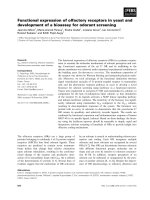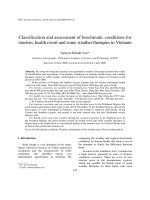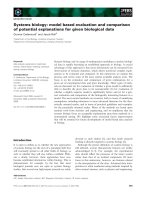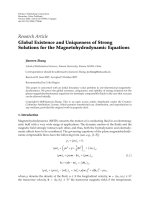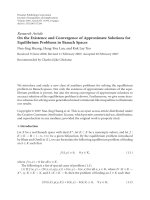Formulation and choice of competitive strategy for green fiberboard JSC
Bạn đang xem bản rút gọn của tài liệu. Xem và tải ngay bản đầy đủ của tài liệu tại đây (1.03 MB, 75 trang )
VIETNAM NATIONAL UNIVERSITY, HANOI
SCHOOL OF BUSINESS
Nguyen Tien Dung
FORMULATION AND CHOICE OF COMPETITIVE
STRATEGY FOR GREEN FIBERBOARD JSC.
MASTER OF BUSINESS ADMIINISTRATION THESIS
Hanoi - 2009
VIETNAM NATIONAL UNIVERSITY, HANOI
SCHOOL OF BUSINESS
Nguyen Tien Dung
FORMULATION AND CHOICE OF COMPETITIVE
STRATEGY FOR GREEN FIBERBOARD JSC.
Major: Business Administration
Code: 60 34 05
MASTER OF BUSINESS ADMIINISTRATION THESIS SUMMARY
Supervisor:
Dr. Nguyen Viet Anh
Hanoi – 2009
vi
TABLE OF CONTENTS
ACKNOWLEDGEMENTS …………………………………………………i
ABSTRACT ……………………………………………………………….ii
TÓM TẮT ……………………………………………………………… iv
TABLE OF CONTENTS ………………………………………………… vi
LIST OF ABBREVIATIONS …………………………………………… ix
LIST OF TABLES ………………………………………………………….x
LIST OF FIGURES ……………………………………………………… xi
INTRODUCTION ………………………………………………………… 1
Necessity of the Thesis ………………………………………………1
Research Purpose ……………………………………………………1
Research Scope ……………………………………………………… 1
Methodology ………………………………………………………… 2
Contribution of the Thesis …………………………………………….2
CHAPTER 1: LITERATURE REVIEW …………………………….… 3
1.1 Strategy Definition ………………………………………………….… 3
1.1.1 Vision ……………………………………………………………… 4
1.1.2 Mission …….………………………………………………………… 4
1.2 External Analysis ……………………………………………………….4
1.2.1 Macro Analysis ………………………………………………….… 4
1.2.1.1 Economic …….………………………………….………………… 4
1.2.1.2 Politics …….…………………………………….………………… 5
1.2.1.3 Socials …….……………………………………………………… 6
1.2.1.4 Technology …….……………………………………….…………….7
1.2.2 Micro Analysis … ……………………………………………………7
vii
1.2.2.1 Potential Competitor …….……………………………………………8
1.2.2.2 Rivalry among Established Companies …… ……………………….9
1.2.2.3 The Bargaining Power of Buyers ……… ………………….….…….9
1.2.2.4 The Bargaining Power of Suppliers ………………………… …….10
1.2.2.5 The Threat of Substitute Products ………………………………… 10
1.3 Internal Analysis …………………………………………………….…11
1.3.1 Value Chain Model … ………………………………………… ….11
1.3.2 Identify Competitive Advantage - Key Success Factors … ….….….15
1.4 Core Competences …………………………………………….…….….16
1.5 Competitive Strategy .………………………………………….…….….17
1.5.1 Cost leadership Strategy … ……………………………….……… 18
1.5.2 Differentiation Strategy … ……………………………….……….…20
1.5.3 Focus Strategy … …………………………………….………….… 21
1.6 SWOT’s Analysis to Formulate Competitive Strategy ……………… 23
CHAPTER 2: ANALYSIS GREEN FIBERBOARD’S SITUATION ….26
2.1 Introduction about the Green Fiberboard JSC …………………….……26
2.2 Analysis of Wood Industry ……………………………………….…….26
2.3 Forecast the development direction (Opportunity & Threats) …….……28
2.3.1 External Analysis in Artificial Wood Industry - PEST Model 28
2.3.1.1 Economic ………………………………………………….……… 28
2.3.1.2 Politics … ………………………………………………… 31
2.3.1.3 Socials … …………………….……………………………….……33
2.3.1.4 Technology … …………………………………………… …….33
2.3.1.5 Integration … ………………………………………………… 34
2.3.2 Internal Analysis in Artificial Wood Industry - Five Forces Model 35
2.3.2.1 Rivalry among Established Companies … …………… …… …35
viii
2.3.2.2 Potential Competitors … ………………………………………… 38
2.3.2.3 The Bargaining Power of Buyers … ………………………………40
2.3.2.4 The Bargaining Power of Suppliers … ……………………………40
2.3.2.5 The Threat of Substitute Products …… ………… ……………….42
2.4 Value Chain Analysis for Green Fiberboard JSC……… ……… ……43
CHAPTER 3: PROPOSE SOLUTION FOR GREEN FIBERBOARD 50
3.1 Orient the development strategy for Green Fiberboard JSC …………50
3.1.1 Vision …….………………………………………………….……… 50
3.1.2 Mission …….……………………………………………….…………50
3.1.3 Value …….……………………………………………………………50
3.1.4 Green Fiberboard’s Objectives to 2012 …… ……………… …… 50
3.2 Key Success Factors … ……………………………………………… 52
3.3 SWOT Analysis to Formulate Green Fiberboard’ Strategy ………… 53
3.4 Select the Competitive Strategy for Green Fiberboard JSC ………… 54
3.4.1 Focus Differentiation Strategy (S-O Strategy) …….………………….54
3.4.2 Average Pricing Strategy (S–T Strategy) …….……………………….54
3.4.3 Distribution Channel Development Strategy (W– O Strategy) … … 55
3.4.4 Branding Strategy (W– T Strategy) …….………………………… …55
3.5 Developing Competitive Strategy for Green Fiberboard JSC …………56
3.5.1 Average Pricing Strategy ((S-T Strategy) … ……………………… 56
3.5.2 Focus Strategy (S-O Strategy) …………………………………… …61
3.5.3 Distribution Channel Development Strategy (W-O Strategy) … ……63
3.5.4 Branding Strategy (W-T Strategy) … ……………………………….64
3.6 Conclusion .…………………………………………………………… 65
REFERENCE
ix
LIST OF ABBREVIATIONS
GF
Green Fiberboard
MDF
Medium Density Fiberboard
HR
Human Resource
JSC
Join Stock Company
FSC
Forest Steawardship Council
WTO
World Trade Organization
R&D
Research and development
KSF
Key Success Factor
BEPL
Bajaj Eco-Tec Products Ltd
FDI
Foreign Direct Investment
CPI
Consumer Price Index
PMDI
Polymeric Methylene Dyphenyl Diisocyanates
xi
LIST OF FIGURES
FIGURE 1.1: FIVE FORCES MODEL BY MICHAEL PORTER ………… 8
FIGURE 1.2: VALUE CHAIN .…………………………………….………11
FIGURE 1.3: PROCESS TO IDENTIFY COMPETITIVE ADVANTAGE .15
FIGURE 1.4: ORGANIZATIONAL OBJECTIVES …………………….24
FIGURE 2.5: VALUE CHAIN ANALYSIS FOR GREEN FIBERBOARD
JOIN STOCK COMPANY ……………………………….….……….… 43
FIGURE 2.8: MDF PRODUCTION PROCESS… ……………………….45
FIGURE 2.10: GREEN FIBERBOARD’S MANAGEMENT CHART…….48
FIGURE 2.11: PRODUCTION UNIT CHART… …………………………49
FIGURE 2.12: GREEN MDF STRATEGIES ………………………….53
x
LIST OF TABLES
TABLE 2.1: GDP GROWTH RATE FROM 2002 TO 2007………………28
TABLE 2.2: ANNUAL INFLATION FROM 2002 TO 2007 ……………29
TABLE 2.3: THE QUANTITY OF MDF IMPORTED IN 2007 ……… 30
TABLE 2.4: LIST OF SUGAR PLANTS AND
BAGASSE ELIMINATED ………………………………………………. 41
TABLE 2.5: EVALUATE OPPORTUNITIES AND THREATS .…………42
TABLE 2.7: MDF PARAMETER …….……………………………………44
TABLE 2.8: GREEN FIBERBOARD’S AGENTS ……………………….46
TABLE 2.9: TOTAL OF GREEN FIBERBOARD’S
HUMAN RESOURCES …………………… …………………………….47
TABLE 3.1: GREEN FIBERBOARD’S OBJECTIVES TO 2012………….51
TABLE 3.2: DESCRIPTION OF AVERAGE PRICING STRATEGY ….56
TABLE 3.3: GREEN FIBERBOARD’S MDF PARAMETER .……………59
TABLE 3.4: DESCRIPTION OF FOCUS STRATEGY … ………………61
TABLE 3.5: DESCRIPTION OF DISTRIBUTION CHANNEL
DEVELOPMENT STRATEGY ……………………………………… ….63
TABLE 3.6: DESCRIPTION OF BRANDING STRATEGY …………….64
1
INTRODUCTION
Necessity of the Thesis
Vietnam has transformed in two decades of rapid. It has opened its door to the
outside world and liberalized its economy. Over past decade, annual growth
has average 7.5%. More and more, the quality of life is improved and high.
Foreign investment is pouring in recent year and the competition in between
domestic and oversea firms is fiercely.
Many enterprises are lacked of competitive competencies and strategy in the
integrated economy. Facing with the above opportunities and threats, the
organizations and firms need to try their best to exist in the severe and violent
environment.
With desire of developing appropriate business strategy for Green Fiberboard
JSC, my thesis concentrates to the Competitive Strategy
Purpose
This thesis aims to find the strengths and weakness, the oppotunities and
threats that Green Fiberboard needs to implement and face. It also evaluates
the effect of internal enviroment and external enviroment to the firm and base
on the evaluation it will propose competitive strategy that is suitable for
Green Fiberboard Join Stock Company.
Research Scope
Thesis only centers the factors that effect to the production capacity of Green
Fiberboard and then implement to formulate competitive strategy for this
company.
2
Methodology
The methodology will be base on by collecting data from newspapers,
magazines, and internet, reviewing all the studies related to competitive
strategies. Statistic method is use to find the trends and characteristics for
analysis factors.
Quantitative survey can help to find out directors’ opinions on the Green
Fiberboard operation.
Contribution of the Thesis
The student hopes this thesis will help other students who are interested in
researching on the competitive strategy in future. And the most important
thing is that this thesis can help Green Fiberboard JSC., having a competitive
strategy for its development.
3
CHAPTER 1: LITERATURE REVIEW
Since it's establishment in April 1948, Dongwha Holdings has developed as a
corporate group that specializes in the manufacture of wood materials. It has
also led the development of the Korean domestic wood industry by
maximizing added-value. The company continuously attempts to enter into
high value-added business areas such as boards, surface materials, and
building interior materials by intensifying wood business that has previously
been the source of the company’s growth. Recently, the company actively
carried out overseas businesses.
Dongwha Holdings believes in being equipped with an innovative business
mind that enables us to respond to changes in a turbulent business
environment, promptly. For half a century, the company has established the
firm basis for shaping the next half of the century into a new era through
ceaseless developments, challenges and diversified changes.
Dongwha Holdings also believes in putting its management philosophy of
customer satisfaction, innovation, and respect for people into practice and
endeavors to establish itself as a reliable business. Not satisfied with being the
leader in the Korean domestic market; Dongwha aims to realize the vision of
being the leader in the Asian wood industry
1.1 Strategy Definition,
A plan that attempts to define a position for the business that utilizes the
competitive advantages that the business has over its competitors
4
1.1.1 Vision
Defines where the organization wants to be in the future. It reflects the
optimistic view of the organization's future.
A Vision statement outlines what a company wants to be. It concentrates on
future; it is a source of inspiration; it provides clear decision-making criteria.
1.1.2 Mission
Defines where the organization is going now, basically describing the
purpose, why this organization exists
A mission statement tells you what the company is now. It concentrates on
present; it defines the customer, critical processes and it informs you about
the desired level of performance.
1.2 External Analysis
1.2.1 Macro Analysis
An organization’s external environment consists of competitors and other
forces outside its industry that are not under the direct control of the business
and its industry. Every business is subject to general forces that are felt in
many industries and that are not usually amenable to influence by a single
organization. These forces can be classified as Economic, Technological,
Social and Political.
1.2.1.1 Economic
Economic growth rate and GDP can effect negatively to consumption of
wood products. When the economic grows strongly, GDP in a country is high,
5
and living standard is improved people will have huge demand for house
construction and furniture consumption both indoor and outdoor.
The fluctuations of local, national, and world economies are related in many
ways, but it is still important to make separate assessments based on
organizational scope. To assess the local situation, an organization might seek
information concerning the economic base and future of the region and the
effects of this outlook on wage rate, unemployment, and the transportation
and commercial base. On the national level, trends in growth, income level,
inflation, balance of payment and taxation are only a few of the indicators of
the ability of the economy to produce and consume goods and services
Some experts saying Vietnam Economy is developing strongly because of
promoting individuals consumption and private investment and foreign direct
investment. The optimistic economic development effect positively to wood
processing industry
Therefore, we can consider that the risk of economy can also cause the risk
for any firm
1.2.1.2 Politics
Political and legal factors have a major affect on the level of opportunities and
threats in the environment and effect to any industry’s existence and
development. For example, One year after Vietnam’s entering WTO, the
wood processing industry for export reached 2.4 billion USD, up to 24.4%
comparing with 2006
Laws influence the hiring and firing of employees, compensation, working
hours, and working conditions. Laws also influence advertising practices, the
pricing of products and corporate growth by mergers and acquisitions. In
6
addition to these laws, governmental tax policies influence the financial
structure and investment decisions of organization. For example, every
wooden processing firms exporting to European and USA markets have to
follow Forest Steawardship Council (FSC), which is an independent, non-
governmental, not for profit organization established to promote the
responsible management of the world’s forests. This organization will issue a
certificate for those firms having good management of forest and that means
the good is not smuggle.
We can say that the political and legal factor can effect strongly to the
countries A developing country jointing into WTO it can be an development
about capital foreign investment and export into international markets.
Beside, in the integration process, the wood manufacturing enterprises in that
county are facing with many risks such as the competition from foreign
producers who have knowledge, money and high technique.
1.2.1.3 Social
Social forces include factors that relate to the values, attitudes, and
demographic characteristics of an organization’s customers. Dynamic social
forces can significantly influence the demand for and organization’s products
or services and can alter its strategic decision. Determining the exact impact
of social forces on an organization’s objectives is difficult at best.
Nevertheless, assessing the changing values, attitudes, and demographic
characteristics of and company’s customers is an essential element in
establishing firm objectives. Population growth and economic development
will intensify the demand of wood products and this will be opportunities for
wood processing industry.
7
In Vietnam, labor source is available and cheap and Vietnamese workers are
skillful which can be advantages for Vietnamese wood firms for competition.
1.2.1.4 Technology
Vietnam wood processing companies are using old equipments, backward
technologies, and that effect to product quality and their competition in the
market. The growth of wood market will be affective to shape and develop the
technology market. Technology exchange and transfer will be faster through
the integration. Technological forces include not only the fascinating
invention that revolutionizes our lives but also the gradual improvements in
methods, in materials, in design, in application, in transmission into new
industries and in efficiency. The effects of wood technological changes are
normally felt in the following ways:
- New products such as artificial wood Particle Board, MDF can be
replacing natural wood
- Alternate processing methods, raw materials such as artificial wood made
from straw, leaf, coffee bark, rice husk
1.2.2 Micro Analysis
The task facing managers is to analyze competitive forces in an industry’s
environment in order to identify the opportunities and threats confronting a
company. Michael E. Porter of the Harvard School of Business
Administration has developed a framework that helps managers in this
analysis. Porter’s framework is known as five forces model.
8
Figure 1.1
Source: M.E.Porter, Competitive Strategy (New York: Free Press 1980)
This model focuses on five forces that shape competition within an industry
- The risk of new entry by potential competitors
- Degree of rivalry among established companies within an industry.
- The bargaining power of buyers
- The bargaining power of supplier
- The threat of substitute products
1.2.2.1 Potential Competitor
Potential competitors are companies that are not currently competing in an
industry but have the capability to do so if they choose. Incumbent companies
(those already operating in an industry) try to discourage potential
competitors from entering the industry, since the more companies enter, the
Threat of entry
by potential
competitors
Rivalry among
established
firms
Bargaining
power of
buyers
Bargaining
power of
suppliers
Threat of
substitute
products
9
more difficult it becomes for established companies to hold their share of the
market and to generate profits. Thus, a high risk of entry by potential
competitors represents a threat to the profitability of established companies.
On the other hand, if the risk of new entry is low, incumbent companies can
take advantage of this opportunity to raise prices and earn greater returns.
The strength of the competitive force of potential rivals largely a function of
the height of barriers to entry. Barriers to entry are factors that make it costly
for companies to enter an industry. The greater the cost that potential
competitors must bear to enter an industry, the greater are the barriers to
entry. High barriers to entry keep potential competitors out of an industry,
even when industry returns are high.
There four main sources of barriers to new entry: brand loyalty, absolute cost
advantages, economic of scale and government regulation.
1.2.2.2 Rivalry among Established Companies
The second of Porter’s five competitive forces is the extent of rivalry among
established companies within an industry. If this rivalry is weak, companies
have an opportunity to raise prices and earn greater profits. If rivalry is strong,
significant price competition, including price wars, may result. The extent of
rivalry among established companies within an industry is largely a function
of three factors: the industry’s competitive structure, demand conditions, the
height of exit barriers in the industry.
1.2.2.3 The Bargaining Power of Buyers
A company’s buyers may be the customers who ultimately consume its
products (its end users), but they may also be the companies that distribute its
products to end users, such as retailers and wholesalers.
10
Buyers can be viewed as a competitive threat when they are in a position to
demand lower prices from the company or they demand better service. On the
other hand, when buyers are weak, a company can raise its prices and earn
greater profits. Whether buyers are able to make demands on a company
depends on their power relative to that of the company.
1.2.2.4 The Bargaining Power of Suppliers
Suppliers can be viewed as a threat when they are able to force up the price
that company must pay for its inputs or reduce the quantity of the inputs they
supply, thereby depressing the company’s profitability. On the other hand, if
suppliers are weak, this gives a company the opportunity to force down prices
and demand higher input quantity. As with buyers, the ability of suppliers to
make demands on a company depends on their power relative to that of the
company.
1.2.2.5 The Threat of Substitute Products
Substitute products are those of industries that serve consumers’ needs in a
way that is similar to those being served by the industry being analyzed. The
existence of close substitutes presents a strong competitive threat, limiting the
price a company can change and thus its profitability. However, if a
company’s products have few close substitutes (that is, if substitutes are weak
competitive force) then, other things being equal, the company has the
opportunity to raise price and earn additional profits.
11
1.3 Internal Analysis
Internal analysis begins with identification of the organization’s resource
allocations. This analysis should produce an list of organizational strengths
and what the organization does well. Strengths must then be analyzed for their
strategic significance. It is also necessary to identify areas of weakness and to
determine whether these weaknesses have strategic significance that is
whether they make the organization vulnerable. All these assessments are
relative and they must incorporate environmental information.
1.3.1 Value Chain
Support
Activities
Figure 1.2
Source: Charlers W.L.Hill and Garethr Jones, Strategic Management: An
Integrated Approach (Houghton 1998)
Primary Activities
Research &
Development
Production
Marketing &
Sales
Service
Company infrastructure
Human resources
Material management
12
An example of material management in the value chain
Flakeboard Company Ltd., a manufacturer of particleboard and MDF based in
Markham, Canada, recently received ISO 14001 certification for its
environmental management system. These systems cover process efficiency,
as well as reducing waste generation and expanding the utilization of
recoverable resources. Dave Moffat, environmental coordinator for
Flakeboard, said, "This registration will be an invaluable toot in managing our
material resources. It showed the demonstration of our commitment and
attention to the resources valued by us, our customers and the community as a
whole." the manufacturing process meets the highest environmental standards
set by the Canadian government and that technologically advanced MDF
equipment is being used to meet these standards plus produce a high-quality
MDF board
The plant has targeted the North American market, particularly the residential
and office furniture industries, although applications also include cabinet
doors, moldings, slot wall, flooring, etc. Superior MDF is available in 4-foot
by 6-foot to 5-foot by 16-foot sheets, with thicknesses ranging from 3/8 inch
to 1 1/8 inches. Plant capacity calls for producing up to 120 million square
feet on a 3/4-inch basis annually
Primary Activities:
Primary activities have to do with the design, creation, and delivery of the
product as well as its marketing and its support and after-sales service.
Research and development (R&D) is concerned with the design of products
and production processes. By superior product design, R&D can increase the
functionality of products, which makes them more attractive to consumers.
13
Alternatively, the work of R&D may result in more efficient production
processes, thereby lowering production cost. Either way, the R&D function of
an enterprise can create value.
Production is concerned with the creation of a good or service. For physical
products, production generally has to do with manufacturing. For services
such as banking or retail operation, production typically takes place when the
service is actually delivered to customer.
Marketing and sales can create value through brand positioning and
advertising. The marketing function can increase the value that consumers
perceive to be contained in a company’s product. Marketing and sales also
create value by discovering consumer needs, and communicating them back
to the R&D function of the company, which can then design product that
better match those needs.
Service function of an enterprise is to provide after-sales service and support.
This function can create a perception of superior value in the minds of
consumers by solving consumers’ problems and supporting consumers after
the have purchased the product.
Support Activities:
The support activities of value chain provide inputs that allow the primary
activities to take place.
The materials management function controls the transmission of physical
materials through the value chain, from procurement through production and
14
into distribution. The efficiency with which this is carried out can
significantly lower cost, thereby creating more value.
Similarly, there are number of ways in which the human resource function
can help an enterprise create more value. The human resource function
ensures that the company has the right mix of skilled people to perform its
value creation activities effectively. It is also the job of the human resource
function to ensure that people are adequately trained, motivated and
compensated to perform their value creation tasks.
The final support activity is the company infrastructure. This has a somewhat
different character from other support activities. Infrastructure has to do with
the companywide context within which all the other value creation activities
take place. The infrastructure includes the organizational structure, control
system, and culture of the company. Since top managers can exert
considerable influence in shaping these aspects of a company, top managers
should be also viewed as part of the infrastructure of a company. Though
strong leadership top management can consciously shape the infrastructure of
a company, and through that the performance of all other value creation
activities that take place within it
15
1.3.1 Identify competitive advantage - Key Success Factors
Figure 1.3 - Identify competitive advantage
Resources: it is the things in the company including tangible or intangible
asset
Capabilities: When the company uses the resources, they become capabilities
Core Competency: the critical/key capabilities are used to compete in the
field of company business activities
Distinctive Competency: This competency overwhelms comparing with
competitors (better competency). However, the competitors easily can copy
and do the same in near future. This is short run strength and we bases on this
to set up tactics for the company
Resources
Capability
Core
Competency
Distinctive
Competency
Sustain Competitive
Advantage
16
Sustainable Competitive Advantage: it costly to imitate when the competency
is better than competitors and also the competitor can not copy or do the same
it is long run strength and we base on this to establish strategy for the
company and also we call it key success factor (KSF)
Key success factors determine the requirements for successful participation in
an industry. KSF vary from one industry to another. Delineating KSF requires
two interrelated activities: analysis of customers and analysis of the factors
that lead to survival in the industry. Analysis of customers requires attention
to three area: Who are the customers? What do they want? How do customers
choose between competing companies?
Analysis of competition often centers on depicting those factors that lead to
market success in an industry. It focuses on examining the factors that
determine the success of leading companies. One must be careful, however,
because success cannot be achieved simply by copying industry leaders.
1.4 Core Competences
Core competencies are capabilities that serve as a source of competitive
advantage for a firm over its rivals. Core competencies emerge over time
through an organizational process of accumulating and learning how to
deploy different resources and capabilities.
Examples of capabilities include management (ability to envision the future of
their industry, effective organizational structure), marketing (effective
promotion of brand-name products, effective customer service, innovative
merchandising), human resources (motivating, empowering and retaining
employees), manufacturing, distribution, management information systems
and research & development.
17
The criteria for determining whether a capability is a core competency is
whether it is capable of producing sustainable competitive advantage. A
capability can deliver competitive advantage without meeting all of the
required criteria, but this will only be for a limited time.
Hanson uses an updated model with four criteria of sustainable competitive
advantage:
- Valuable means the capability allows the firm to exploit opportunities or
neutralize threats in its external environment
- Rare means capabilities that few, if any, of its competitors possess
- Costly to imitate that means capabilities that other firms cannot easily
develop. Take note however, this does not simply mean it is expensive to
imitate, it means it is difficult to imitate (i.e. the capability developed
through unique historical conditions, the capability itself is ambiguous or
the relationships that underpin the capability are complex to understand
and imitate).
- Non-substitutable: the capability does not have a strategic equivalent. One
example is R&D, the objective of which is obtaining new technology. To
obtain new technology you could develop it internally, or you could
monitor the external environment for developments then acquire them and
these are strategic equivalents.
1.5 Competitive Strategy
There are three potentially successful common approaches to outperforming
other firms in an industry
- Cost leadership Strategy

